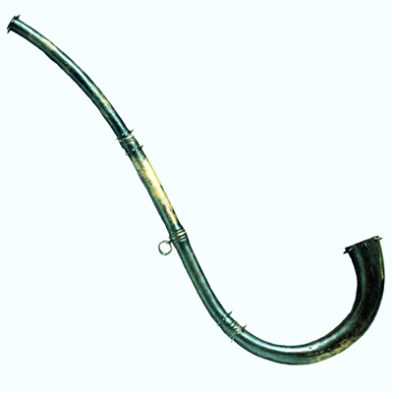Horns, Trumpets & Pipes
Ancient Music Ireland’s journey into manufacturing new Bronze Age horns and trumpets.
In 1987, Dr Eamon Kelly, Keeper of Antiquities at the National Museum of Ireland expressed an invitation for a lip-reed player to look at the Bronze Age horns and trumpets with a view to establishing whether they could be played. This was after the 1974 paper presented by Dr Peter Holmes on the manufacture of the Bronze Age horns and trumpets of Ireland and Britain at Trinity College Dublin. He included an opinion with a practical demonstration that the ancient instruments may have been played in a similar fashion to lip-reed players. At this time Simon O’Dwyer (co-founder Ancient Music Ireland) was experimenting and exploring the idea of using a drone sound to accompany traditional Irish melody by playing plastic and wooden pipes.
Accepting Eamon Kelly’s invitation to the National Museum the first instrument examined was the ‘Derrynane horn’ that was stored in the crypt at the time. On this first visit to the Museum, O’Dwyer got to see a large storage space in the crypt full of complete and parts of Bronze Age and Iron Age instruments. Realising the possibility of making music on the ‘Derrynane horn’, it was clear that to achieve this, a new reproduction would need to be made to allow for experimentation and practice. Though this instrument was reproduced at a later date, the first instruments made in modernity were copied from a trumpet and a horn that are in the keeping of the Ulster Museum in Belfast, Co. Antrim.
Bronze Age Horn Classifications
The Bronze Age wind instruments of Ireland and Britain are classed as either horns or trumpets. Hoards of instruments have mostly been found with horns and trumpets together or multiples as pairs.
A horn is conical along it’s length with a mouthpiece to facilitate the embouchure in the side of the instrument.
A trumpet has a conical bell and a cylindrical tube added with the mouthpiece to facilitate the embouchure at the end of the instrument.
Below are 7 examples of Bronze Age horns and trumpets made by and in the keeping of Ancient Music Ireland
References
O’Dwyer, S. Four Voices of the Bronze Age horns of Ireland, E. Hickmann/Ingo Laufs/R. Eichmann (eds.), Music Archaeology of Early Metal Ages. Paper from the 1st Symposium of of the International Study Group on Music Archaeology at Monastery Michaelstein, 18-24 May, 1998. Studien zur Musikarchäologie II, Orient-Archäologie 7, 337-340. Rahden/Westf. 2000. link to paper
Purser, J. The Sounds of Ancient Scotland. Paper from the 1st Symposium of of the International Study Group on Music Archaeology at Monastery Michaelstein, 18-24 May, 1998. Studien zur Musikarchäologie II, Orient-Archäologie 7, Rahden/Westf. 2000. link to paper
O’Dwyer, S. Ancient Music and Instruments of Ireland and Britain. Pages 27 – 62.
The Fipple Pipes
Fipple pipes – modern designed fipples – 2004 AD taken from Wicklow pipes, Charlesland, Co. Wicklow, Ireland – 2,134 BC - National Museum of Ireland.
In 2003 a set of six cylindrical pipes made from yew wood were discovered during an archaeological excavation of an early bronze age site in North County Wicklow, Ireland. The six tubes had been deliberately laid out together in the bottom of a wood lined trench known as a fuladh fiadh. Trenches like this are common throughout ancient Ireland and are believed to have been used to cook food or make beer. Carbon dating has established that the pipes were deposited in 2,134 BC whilst the wood lining is appoximately ten years older. It is not known why the pipes were carefully deposited. It is rare that objects are found in fuladh fiadh sites.
The six wooden tubes are complete enough to be copied accurately. In 2004 Dr. Peter Holmes made the first accurate reproduction set and presented his findings at the 4th International Study Group of Music Archaeology in the same year. Each original pipe has a carved socket at one end to facilitate a tone generator. These extensions or tone generators were not found at the site not included in the deposition or may have been made of another organic material that dissolved over time.
In 2018 Ancient Music Ireland consulted with Ian Lambe, a professional low whistle maker to discuss the possibilities for making fipples to sound this new set of pipes. Ian designed and make six identical specialised fipples to bring out the best possible musical qualities and tuning of each pipe. They were then fitted by uillean pipes maker Eugene Lambe. The resulting notes that could be played were surprisingly modern in both their tuning and the intervals between each one. The six pipes are made of yew wood and have the same internal and external diameter. As the fipples are also identical, the intervals are achieved solely through the different lengths of the pipes. Thus, the original ‘Wicklow pipes’ give us a unique window into a musical tuning that was in use in Ireland over 4,000 years ago.












